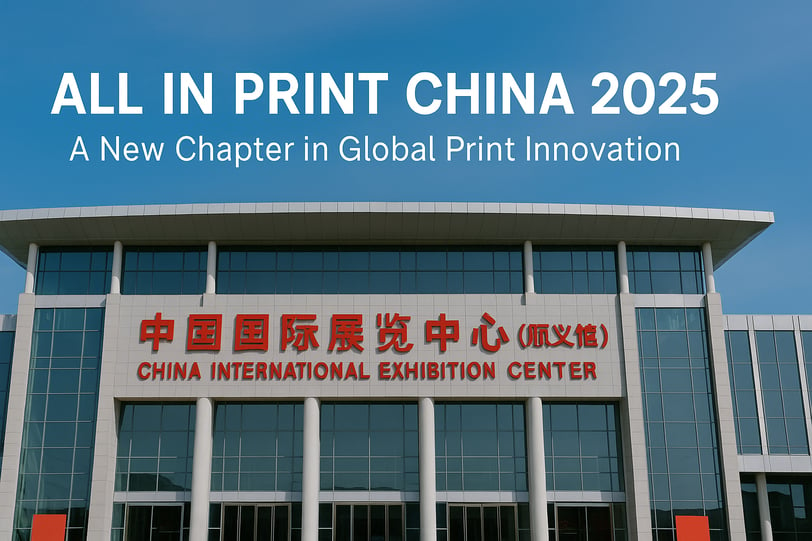Inside All in Print China 2025: Where Print Met Its Digital Future
Join me as I explore key trends from All in Print China 2025, where inkjet ruled, embellishment dazzled, and Chinese tech won global trust.
PRINTINNOVATIONPRINTECONOMICSINKJETPRINTING
Aaseem A Kulkarni
5/21/20253 min read


Reflections from All in Print China 2025: Trust, Technology, and Transformation in the Heart of Beijing
I had the opportunity to attend All in Print China 2025, held in Beijing from May 15th to 19th, and I must say—this edition felt different. It wasn’t just another exhibition; it was a powerful statement about where the print industry stands today and where it’s headed. For someone who’s spent decades in this space, it was energizing to witness such momentum, innovation, and global convergence all under one roof.
A Shift in Global Trust: Chinese Manufacturing Steps Up
One of the most noticeable changes this year was the international character of the audience. Unlike earlier editions—where footfalls were largely domestic—this time I met visitors from across Asia, Europe, Africa, and even Latin America. More importantly, they weren’t just passersby. They were decision-makers—business owners, procurement heads, and C-level executives. Conversations were direct and purposeful, with real interest in forming partnerships and placing orders.
This growing international presence speaks volumes about how Chinese print equipment manufacturers are now commanding global trust. The narrative has shifted from “low-cost alternatives” to “credible, competitive solutions”—backed by innovation, reliability, and scale.
Inkjet Takes Center Stage: From Commercial Print to Packaging
What excited me most was the sheer dominance of digital inkjet printing across the exhibition floor. It’s no longer a fringe technology—it’s mainstream. For years, we’ve spoken about the potential of inkjet to disrupt offset in commercial printing. At this show, it was clear that that disruption is already well underway.
Even more interesting was how inkjet is beginning to carve out space in the packaging segment, traditionally a stronghold of flexo and gravure. The buzz around 880 mm wide inkjet presses—like Atexco’s—was real. Designed to handle wide range of substrates with high-speed precision, these presses promise to bridge the gap between customization and production-scale output. We’re looking at a future where shorter print runs, versioning, and rapid turnarounds will become the norm, even in packaging.
The Need to Stand Out: Digital Embellishment Is No Longer Optional
Another standout trend was the surge in digital embellishment solutions—particularly for cut-sheet digital prints. In today’s CMYK-saturated world, everyone’s looking for ways to create “wow” moments. That’s where embellishments like foiling, spot UV, 3D textures, and tactile finishes make all the difference.
What I found particularly compelling was how many solutions now offer inline digital enhancement—bringing efficiency and design freedom together. For brands, this means elevated shelf presence; for printers, it means value-added services and better margins. It's no longer about just printing—it’s about making prints that speak, sparkle, and sell.
Digital Labels: Still on Fire, Still Inkjet-Led
The digital label printing segment continues its upward trajectory—and inkjet is still in the driver’s seat. From full-color short-run labels to variable data printing, the level of sophistication on display was impressive.
I noticed a wide variety of label presses tailored for different substrates and application types, whether it was paper-based labels for FMCG or film-based ones for personal care products. Equally exciting were the finishing options—modular systems that allowed for die-cutting, varnishing, laminating, and slitting—all inline.
What struck me was how well-integrated these systems have become. Printers now have access to complete end-to-end solutions, reducing wastage, lowering turnaround times, and enabling high-quality, just-in-time label production.
Innovation Galore: The Technology Highlights
All in Print 2025 also served as a launchpad for some cutting-edge developments. Here are a few that really stood out:
AI-powered workflow tools that predict maintenance needs, automate color management, and optimize print queues.
Eco-conscious solutions—from water-based inks and recyclable substrates to energy-saving curing systems—highlighting the industry's commitment to sustainability.
Augmented Reality (AR) print applications, merging physical print with immersive digital experiences, a particularly exciting frontier for marketing and education.
These innovations aren’t just about keeping up—they’re about shaping the next decade of print.
A New Energy: Why This Show Felt Different
In conversations with peers and exhibitors, a common sentiment echoed: this edition felt like a turning point. The exhibition halls were packed—not just in numbers but in intent. Exhibitors I spoke with had serious business leads, distributor inquiries, and even orders booked on-site.
There was less foot traffic for freebies and more meaningful engagement. That speaks volumes about how our industry is evolving—more strategic, more global, more focused.
Final Thoughts
All in Print China 2025 reaffirmed what I’ve long believed: print is not dying—it’s transforming. It’s getting smarter, faster, greener, and far more valuable than ever before.
For us at Fujito, and for those of us promoting technologies like Atexco’s inkjet solutions and advanced digital label presses, this exhibition was both a validation and a call to action. The world is ready. Our markets are curious. And innovation is not just welcome—it’s expected.
As I flew back, tired but energized, one thing was clear—the future of print is being written now, and All in Print China 2025 just turned the page.